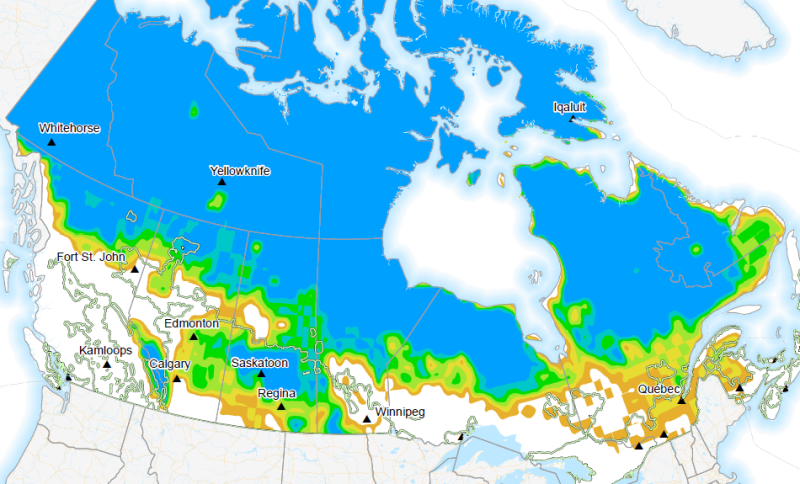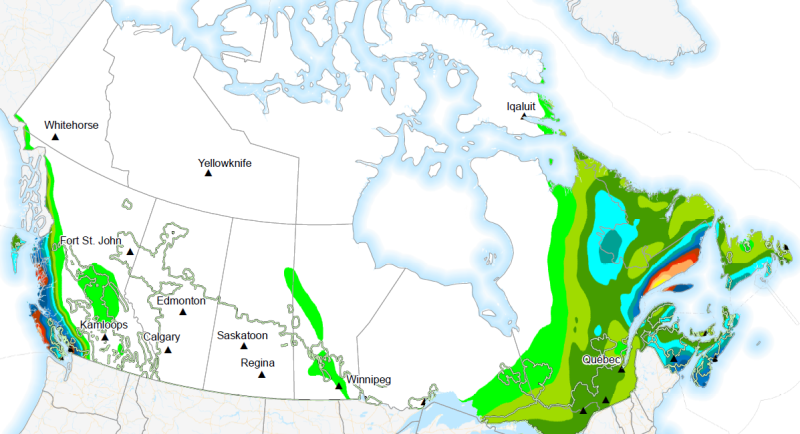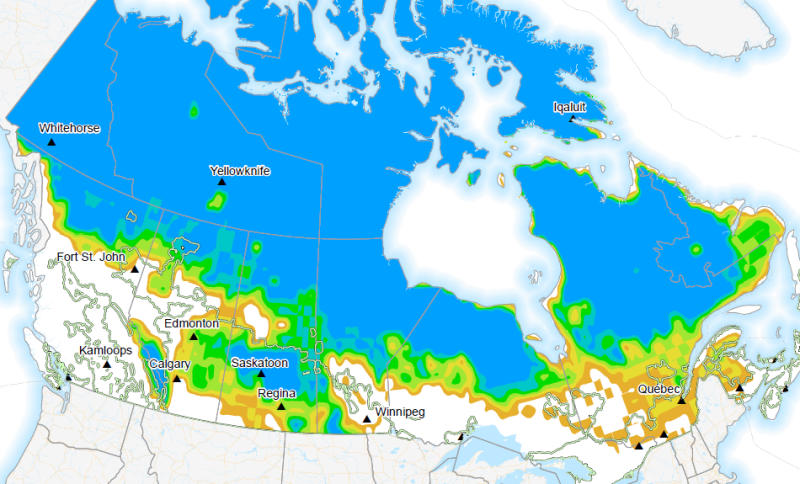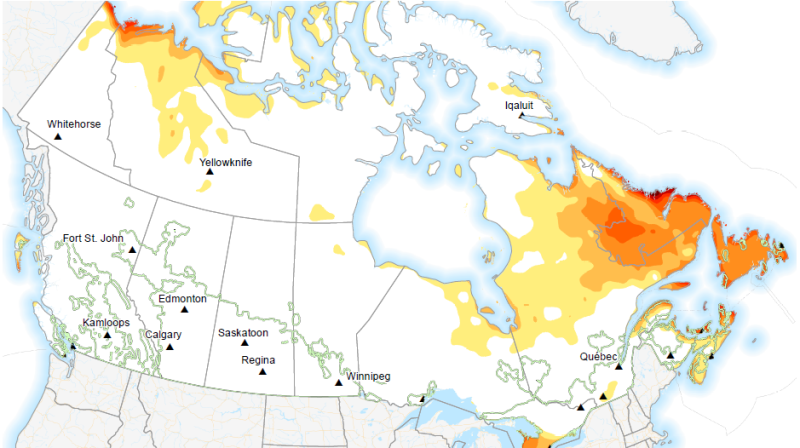climatologyMeteorologyAtmosphere
Type of resources
Available actions
Topics
Keywords
Contact for the resource
Provided by
Years
Formats
Representation types
Update frequencies
status
Scale
Resolution
-

Gögnin innhalda staðsetningu veðurstöðva sem eru í eigu Vegagerðarinnar og staðsettar eru við þjóðvegi en einnig veðurstöðvar í eigu Veðurstofunnar og annarra.
-

The monthly mean is the average of daily mean values for a given month.
-

The number of days in the forecast period with a minimum temperature below the frost temperature. It is -15°C for herbaceous crops over the dormant period (ifd_herb_dorm). Week 1 and week 2 forecasted index is available daily from November 1 to March 31. Week 3 and week 4 forecasted index is available weekly (Thursday) from November 1 to March 31. Over-wintering crops are biennial and perennial field crops such as herbaceous plants (strawberry, alfalfa, timothy, and many other forage crops) and woody fruit trees (apple, pear, peach, cherry, plum, apricot, chestnut, pecan, grape, etc.). These crops normally grow and develop in the growing season and become dormant in the non-growing season. However, extreme weather and climate events such as cold waves in the growing season and ice freezing events during the winter are a major constraint for their success of production and survival in Canada. The winter survival of these plants depends largely on agrometeorological conditions from late autumn to early spring, especially ice-freezing damage during the winter season. Agriculture and Agri-Food Canada (AAFC) and Environment and Climate Change Canada (ECCC) have together developed a suite of extreme agrometeorological indices based on four main categories of weather factors: temperature, precipitation, heat, and wind. The extreme weather indices are intended as short-term prediction tools and generated using ECCC’s medium range forecasts to create a weekly index product on a daily and weekly basis.
-
Environment and Climate Change Canada’s (ECCC) Climate Research Division (CRD) and the Pacific Climate Impacts Consortium (PCIC) previously produced statistically downscaled climate scenarios based on simulations from climate models that participated in the Coupled Model Intercomparison Project phase 5 (CMIP5) in 2015. ECCC and PCIC have now updated the CMIP5-based downscaled scenarios with two new sets of downscaled scenarios based on the next generation of climate projections from the Coupled Model Intercomparison Project phase 6 (CMIP6). The scenarios are named Canadian Downscaled Climate Scenarios–Univariate method from CMIP6 (CanDCS-U6) and Canadian Downscaled Climate Scenarios–Multivariate method from CMIP6 (CanDCS-M6). CMIP6 climate projections are based on both updated global climate models and new emissions scenarios called “Shared Socioeconomic Pathways” (SSPs). Statistically downscaled datasets have been produced from 26 CMIP6 global climate models (GCMs) under three different emission scenarios (i.e., SSP1-2.6, SSP2-4.5, and SSP5-8.5), with PCIC later adding SSP3-7.0 to the CanDCS-M6 dataset. The CanDCS-U6 was downscaled using the Bias Correction/Constructed Analogues with Quantile mapping version 2 (BCCAQv2) procedure, and CanDCS-M6 was downscaled using the N-dimensional Multivariate Bias Correction (MBCn) method. The CanDCS-U6 dataset was produced using the same downscaling target data (NRCANmet) as the CMIP5-based downscaled scenarios, while the CanDCS-M6 dataset implements a new target dataset (ANUSPLIN and PNWNAmet blended dataset). Statistically downscaled individual model output and ensembles are available for download. Downscaled climate indices are available across Canada at 10km grid spatial resolution for the 1950-2014 historical period and for the 2015-2100 period following each of the three emission scenarios. Note: projected future changes by statistically downscaled products are not necessarily more credible than those by the underlying climate model outputs. In many cases, especially for absolute threshold-based indices, projections based on downscaled data have a smaller spread because of the removal of model biases. However, this is not the case for all indices. Downscaling from GCM resolution to the fine resolution needed for impacts assessment increases the level of spatial detail and temporal variability to better match observations. Since these adjustments are GCM dependent, the resulting indices could have a wider spread when computed from downscaled data as compared to those directly computed from GCM output. In the latter case, it is not the downscaling procedure that makes future projection more uncertain; rather, it is indicative of higher variability associated with finer spatial scale. Individual model datasets and all related derived products are subject to the terms of use (https://pcmdi.llnl.gov/CMIP6/TermsOfUse/TermsOfUse6-1.html) of the source organization.
-
Multi-model ensembles of sea ice concentration based on projections from twenty-eight Coupled Model Intercomparison Project Phase 5 (CMIP5) global climate models are available for 1900-2100. Specifically, the 5th, 25th, 50th, 75th and 95th percentiles of the monthly, seasonal and annual ensembles of sea ice concentration as represented as the percentage (%) of grid cell area, are available for the historical time period, 1900-2005, and for emission scenarios, RCP2.6, RCP4.5 and RCP8.5, for 2006-2100. Note: Projections among climate models can vary because of differences in their underlying representation of earth system processes. Thus, the use of a multi-model ensemble approach has been demonstrated in recent scientific literature to likely provide better projected climate change information.
-

A station is a site on a river or lake where water quantity (water level and flow) are collected and recorded.
-

The greatest daily precipitation over the forecast period (p1d). Week 1 and week 2 forecasted index is available daily from September 1 to August 31. Week 3 and week 4 forecasted index is available weekly (Thursday) from September 1 to August 31. Units: mm Precipitation (moisture availability) establishes the economic yield potential and product quality of field crops. Both dry and wet precipitation extremes have the ability to inhibit proper crop growth. The greatest daily precipitation index covers the risk of excessive precipitation in the short term, while the other indices pertain to longer term moisture availability. Agriculture and Agri-Food Canada (AAFC) and Environment and Climate Change Canada (ECCC) have together developed a suite of extreme agrometeorological indices based on four main categories of weather factors: temperature, precipitation, heat, and wind. The extreme weather indices are intended as short-term prediction tools and generated using ECCC’s medium range forecasts to create a weekly index product on a daily and weekly basis.
-

Cool Wave Days are the number of days in the forecast period with a minimum temperature below the cardinal minimum temperature, the lowest temperature at which crop growth will begin (dcw_cool). This temperature is 5°C for cool season crops. Week 1 and week 2 forecasted index is available daily from April 1 to October 31. Week 3 and week 4 forecasted index is available weekly (Thursday) from April 1 to October 31. Cool season crops require a relatively low temperature condition. Typical examples include wheat, barley, canola, oat, rye, pea, and potato. They normally grow in late spring and summer, and mature between the end of summer and early fall in the southern agricultural areas of Canada. The optimum temperature for such crops is 25°C. Agriculture and Agri-Food Canada (AAFC) and Environment and Climate Change Canada (ECCC) have together developed a suite of extreme agrometeorological indices based on four main categories of weather factors: temperature, precipitation, heat, and wind. The extreme weather indices are intended as short-term prediction tools and generated using ECCC’s medium range forecasts to create a weekly index product on a daily and weekly basis.
-

The number of days during the forecast period with an average wind speed greater than 30 km/h (nswd). Week 1 and week 2 forecasted index is available daily from September 1 to August 31. Week 3 and week 4 forecasted index is available weekly (Thursday) from September 1 to August 31. Winds can significantly influence crop growth and yield mainly due to mechanical damage of plant vegetative and reproductive organs, an imbalance of plant-soil-atmosphere water relationships, and pest and disease distributions in agricultural fields. The maximum wind speed and the number of strong wind days over the forecast period represent short term and extended strong wind events respectively. Agriculture and Agri-Food Canada (AAFC) and Environment and Climate Change Canada (ECCC) have together developed a suite of extreme agrometeorological indices based on four main categories of weather factors: temperature, precipitation, heat, and wind. The extreme weather indices are intended as short-term prediction tools and generated using ECCC’s medium range forecasts to create a weekly index product on a daily and weekly basis.
-
The Agri-Environmental Indicator of Risk of Water Contamination by Phosphorus dataset estimates the relative risk of phosphorus loss from Soil Landscapes of Canada agricultural areas to surface water. The data series for this indicator consists of four (4) datasets: Annual P-Balance, Soil-P-Source, Edge of Field and IROWC-P. Products in this data series present results for predefined areas as defined by the Soil Landscapes of Canada (SLC v.3.2) data series, uniquely identified by SOIL_LANDSCAPE_ID values.
 Arctic SDI catalogue
Arctic SDI catalogue